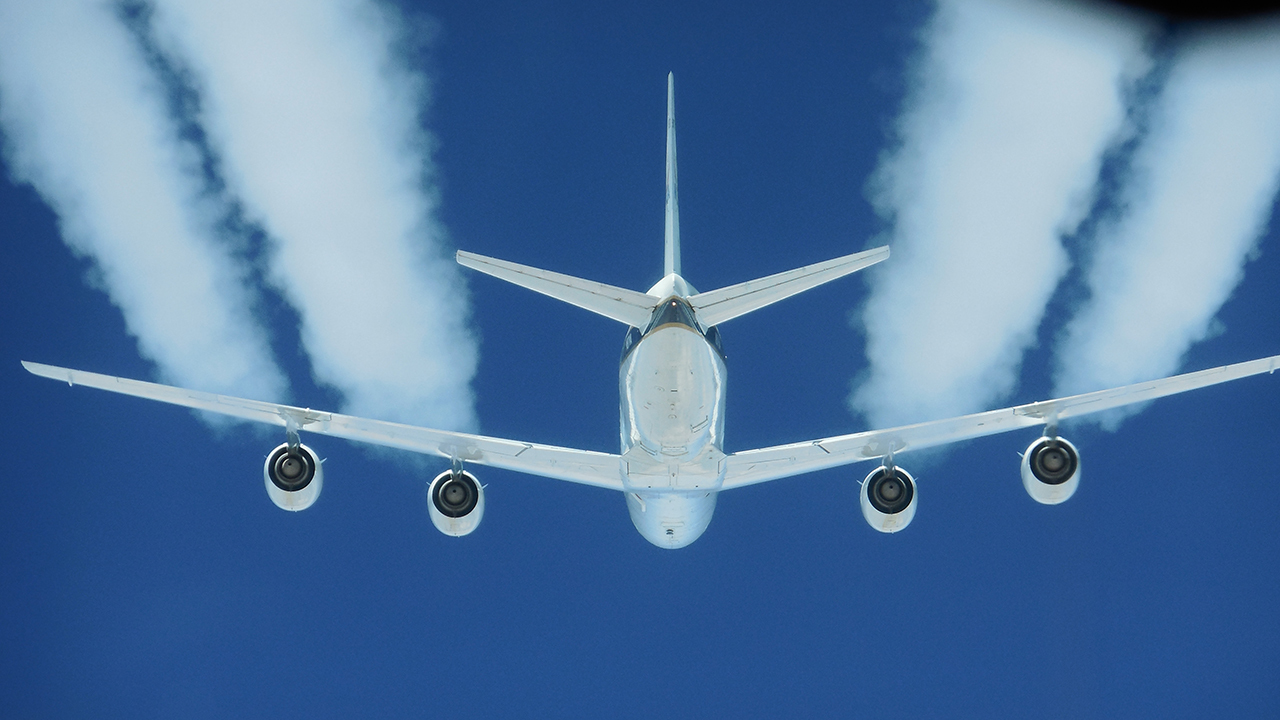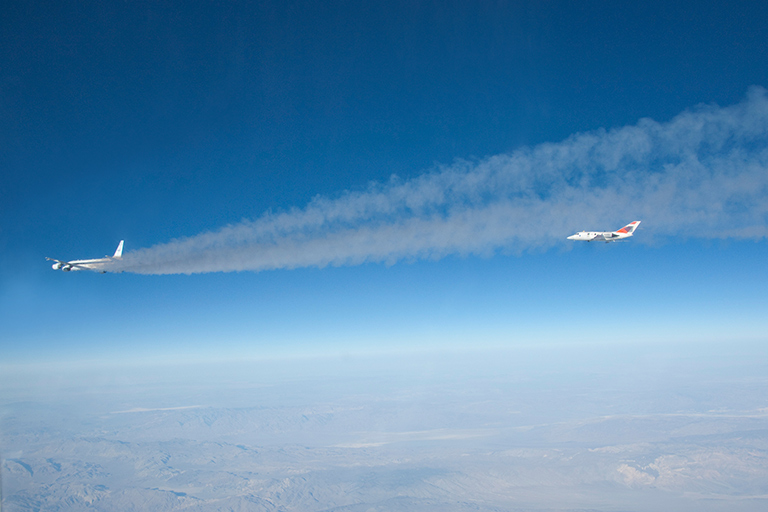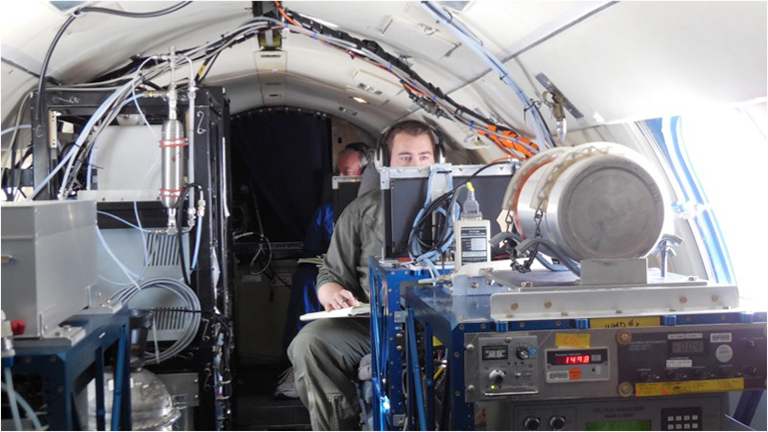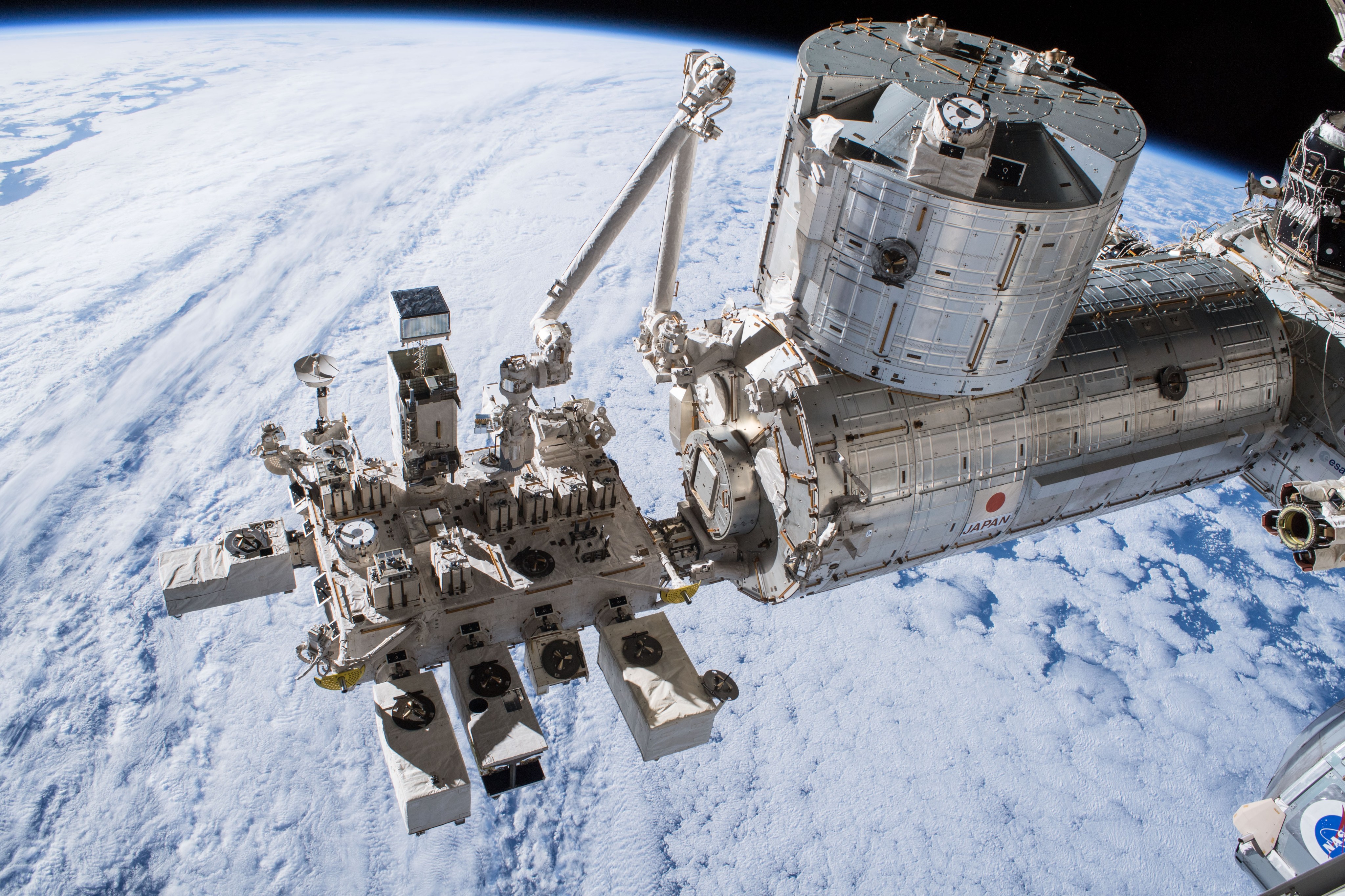7 min read

- NASA tests in flight conditions show that blending standard jet fuel with biofuel reduces emission of soot particles from jet engines.
- With fewer soot particles, it is likely but not yet proven that jet planes would form thinner, less dense contrails and cirrus clouds, which would reduce their contribution to global warming.
- NASA plans further tests in cooperation with the German Aerospace Center to improve understanding of these processes.
When you see long, white streamers trailing behind a jet plane high in the sky, you’re watching clouds in the making.
The streamers are called “contrails” (short for condensation trails) and consist of ice crystals that form when water vapor from jet-engine exhaust condenses and freezes in the frigid air where these planes cruise.
Depending on atmospheric conditions, a contrail may evaporate quickly or it may last. The persistent ones, buffeted by wind, can spread out into diffuse cirrus clouds. As delicate as these clouds appear, they have a significant warming effect on the planet.
Although cirrus clouds serve as cooling sunshades during the day, they also act as warming blankets both day and night, preventing the Earth from cooling off after the day’s sunbathing as much as it would without the clouds. In fact, the cirrus clouds formed by the world’s aircraft on an average day have a greater warming impact than all the carbon dioxide that aircraft have emitted since the Wright Brothers made the first powered flight in 1903.
That eye-opening comparison is according to a colleague cited by Bruce Anderson and Richard Moore, the project scientist and deputy project scientist, respectively, of NASA’s Alternative Fuel Effects on Contrails and Cruise Emissions Study (ACCESS). Their experiments were designed to see what effect a half-and-half blend of standard jet fuel and a biofuel derived from camelina oil would have on jet-engine emissions.
Jet exhaust includes water vapor, carbon dioxide and soot, the carbon left over from incomplete combustion. Soot particles can provide the surfaces that water vapor requires before it can condense and freeze into ice crystals. So, according to current theory, reducing the number of soot particles that jet engines emit should reduce the density of contrails and the cirrus clouds they form, degrading their ability to warm the planet.
The scientists found that the biofuel blend they tested reduced the amount of soot by a range of 50 percent (when the engines were set to high thrust) to 70 percent (at lower thrust).
Does that mean a 50 to 70 percent reduction in contrails and the resulting cirrus clouds? These experiments couldn’t directly answer that question, but they’re a good start.
“It’s a complicated process,” Anderson said. “There is speculation that even if you did not have soot coming out of the back of an aircraft engine, in many cases a contrail would still form.” That’s because airborne dust, pollen, sea salt and other kinds of naturally occurring particles are also able to provide surfaces that enable water vapor to condense and form clouds.
And there’s another twist: Biofuel contains more hydrogen than standard jet fuel and the hydrogen is converted to water vapor as the fuel burns. If using biofuel creates more water vapor, it’s possible that it will create more contrail than standard jet fuel, not less.

On the other hand, the added water vapor might simply condense around the smaller number of available soot particles, making larger, heavier ice crystals. And heavier crystals are likely to sink to lower, warmer altitudes more quickly than their lighter counterparts. “A lot of air traffic routes are right at the bottom of the (level of the) atmosphere where it's cold enough to form contrails,” Anderson said. “So if a contrail falls to lower altitudes, it evaporates and goes away much more quickly.”
Also, he added, the soot particles from biofuel tend to be smaller than those from standard jet fuel. A significant portion may be too small to seed ice crystals.
So how much effect would reducing soot emissions from jet engines actually have on formation of cirrus clouds? “That’s really hard to tease out observationally,” Moore said.
“We obviously can't measure behind every aircraft,” Anderson said. “And so, a lot of the work we are doing is to gather data to validate model predictions.”
“We really need models, particularly large-scale climate models that incorporate aviation, to unravel some of those effects,” Moore said. “We are providing the input, and the hope is that modelers will take this data, simulate the clouds and try to understand what the impact of reduced particles associated with biofuel blending would be on contrail frequency, lifetime and climate effects.”
Before ACCESS, the scientific literature showed few direct measurements at cruise altitudes of emissions from jet engines burning standard fuel and none at all of jets burning biofuel.
Testing in actual flight conditions is essential because the conditions of both engines and atmosphere are quite different at altitude than on the ground.
Anderson and Moore conducted their experiments at NASA’s Armstrong Flight Research Center in Palmdale, California, in 2013 and 2014. After lengthy analysis and running the gauntlet of the peer-review process, they reported the study’s results in the journal Nature in spring 2017.
The NASA team that Anderson and Moore led went it alone in the 2013 tests. In 2014, they were joined by researchers from the German Aerospace Center (DLR) and the National Research Council (NRC) of Canada.

In those tests, NASA, the DLR and NRC-Canada each provided research aircraft equipped with state-of-the-art instruments capable of sniffing and analyzing the exhaust of NASA’s DC-8 as it sequentially burned two kinds of conventional jet fuel and a 50–50 blend of standard fuel and biofuel.
The research planes took turns sampling the DC-8’s exhaust at distances as close as 100 feet (30 meters) behind the turbofan engines. “It was kind of a tightly choreographed dance,” Moore said. All this, as the planes soared above the Mojave Desert at 30,000 to 36,000 feet (about 9,100 to 11,000 meters), altitudes common for commercial airliners.
The dry desert air reduced the chances that contrails would form, which the scientists considered an advantage in this round of tests. “By not measuring in contrail-forming conditions, we have a more accurate assessment of the number of particles that came out,” Moore said. “Because once you form the cloud, the soot particles start to interact with each other and it actually changes the properties of the soot and the contrail as that system evolves.”
In 2015, the ACCESS team took part in a German-sponsored study that, Anderson said, provided evidence that cutting down on soot reduces formation of ice crystals. And NASA plans to collaborate with the DLR still further.
“We hope to take the DC-8 to Germany in January 2018 and repeat some of the things that we did in ACCESS with a much better suite of instruments,” Anderson said.
“We’re going to do the experiments where conditions are a little more right for forming contrails (in air that is more humid),” Moore said, “in a way that doing flights over Armstrong in the middle of the Mojave Desert is perhaps not.”
“We will get into situations where we have persistent contrails,” Anderson said. “We also plan to fly through the North Atlantic Flight Corridor and sample ice particles forming downwind (of flight paths) to see whether they have black carbon cores, which would verify that they are caused by aircraft emissions.”






